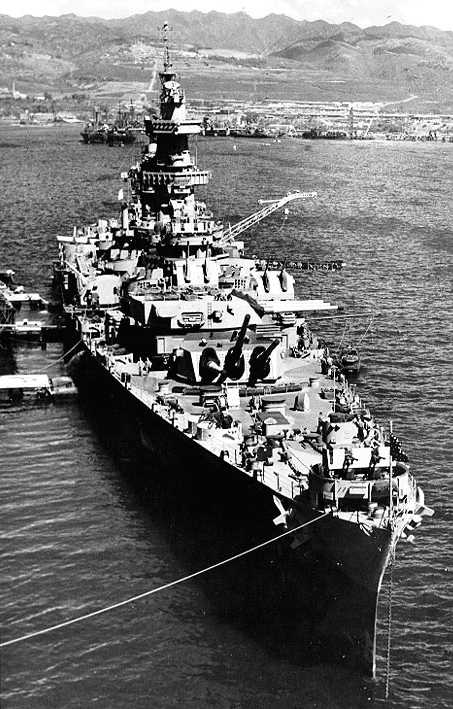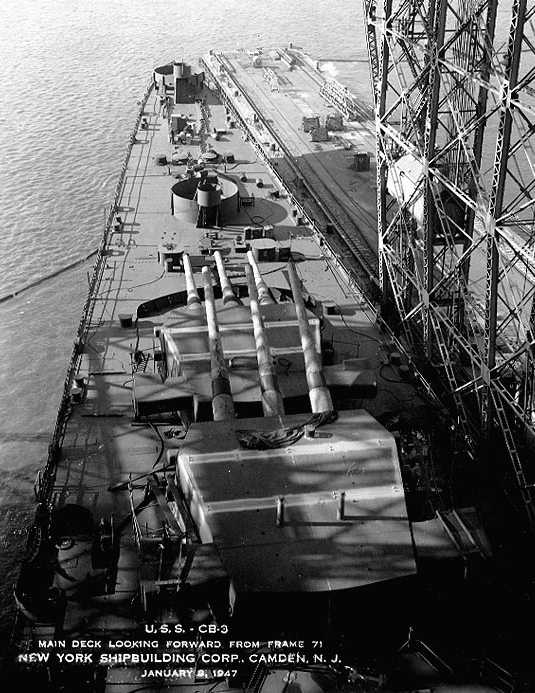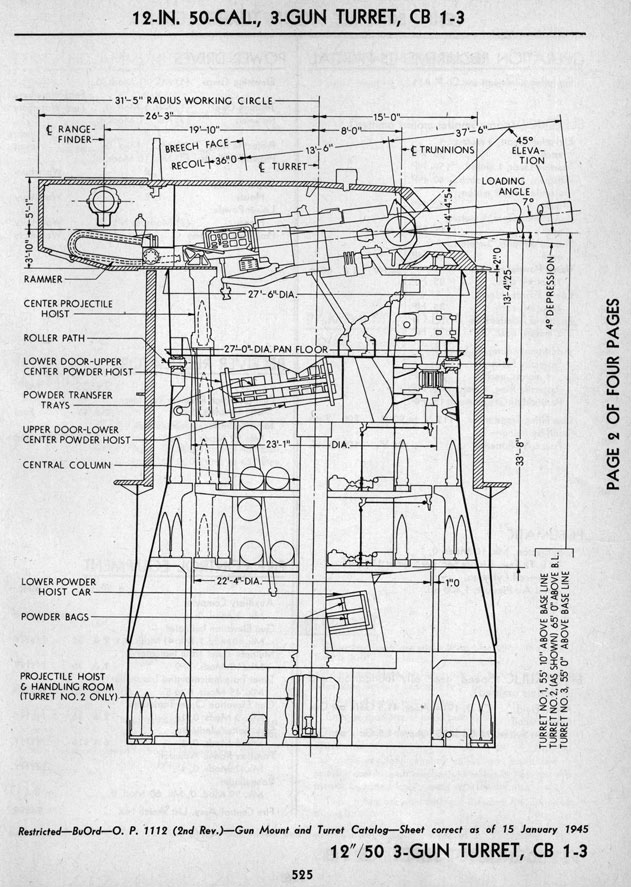
This gun was a major improvement over the 12"/50 (30.5 cm) Mark 7 guns used on the USS Wyoming (BB-32) class and was of a simpler, lighter construction. Designed to fire the new "super-heavy" AP projectiles, their side belt armor penetration at 20,000 to 30,000 yards (18,290 to 27,430 m) was almost identical to and the deck plate penetration better than the larger 14"/50 (35.6 cm) guns used on U.S. pre-treaty battleships.
The manufacturing of these guns shows the changes brought about by the massive production increases caused by World War II. While the 16"/45 (40.6 cm) guns and turrets for the battleship North Carolina and her sister were made almost entirely at the Naval Gun Factory in Washington D.C., the rapid acceleration in shipbuilding during the war forced the Navy to move much of the production of heavy guns to other manufacturers. As a result, the forgings for the 12"/50 (30.5 cm) Mark 8 guns were made by Midvale and Bethlehem Steel Corporations and then sent to the Naval Gun Factory for processing. The Watervliet Arsenal also worked on the guns until they were approximately 65 percent complete and then sent them back to the Naval Gun Factory where the guns were finished. The turrets for these ships were built at the Naval Gun Factory.
On 14th December 1944, Alaska expended 33 rounds of AP Mark 18 at a mean range of 28,000 yards (25,600 m). The mean dispersion was 0.407 percent of range (standard deviation +/- 0.02 percent). Mean MPI error was 178 yards (163 m) and a standard deviation of +/- 119 yards (109 m).
Constructed of liner, jacket, three hoops, two locking rings and a screw box liner. The bore was chromium plated. Used a down-swinging hydraulically operated Welin breech with Smith-Asbury mechanism, similar to the newer battleships. The first prototype gun was completed in January 1942.
| Designation | 12"/50 (30.5 cm) Mark 8 |
|---|---|
| Ship Class Used On | Alaska (CB-1) class |
| Date Of Design | 1939 |
| Date In Service | 1944 |
| Gun Weight | 121,856 lbs. (55,262 kg) (including breech)
108,800 lbs. (49,351 kg) (without breech) |
| Gun Length | 612 in (15.545 m) |
| Bore Length | 600 in (15.240 m) |
| Rifling Length | 511.96 in (13.004 m) |
| Grooves | 72 |
| Lands | N/A |
| Twist | Uniform RH 1 in 25 |
| Chamber Volume | 11,863 in3 (194.4 dm3) |
| Rate Of Fire | 2.4 - 3.0 rounds per minute |
| Type | Bag |
|---|---|
| Projectile Types and Weights 1 2 | AP Mark 18 Mod 1 - 1,140 lbs. (517.093 kg)
HC Mark 17 Mods 1 and 2 - 940 lbs. (426.38 kg) |
| Bursting Charge | AP Mark 18 - 17.4 lbs. (7.9 kg) Explosive D
HC Mark 17 - 79.44 lbs. (36.0 kg) Explosive D |
| Projectile Length | AP Mark 18 - 54.00 in (137.2 cm)
HC Mark 17 - 50.18 in (127.5 cm) |
| Propellant Charge 3 | Full Charge - 275.00 lbs. (124.7 kg) SPD
Special Charge - 245.00 lbs. (111.1 kg) SPD Reduced Charge - 135.00 lbs. (61.2 kg) SPD
|
| Muzzle Velocity | Full Charge - New Gun
AP - 2,500 fps (762 mps) HC - 2,650 fps (808 mps) Special Charge - New Gun
Reduced Charge - New Gun
|
| Working Pressure | 18.0 tons/in2 (2,835 kg/cm2) |
| Approximate Barrel Life | 344 rounds |
| Ammunition stowage per gun | 166 rounds |
- ^AP projectiles had the windshield threaded to the AP cap and held in place by five equally spaced notches which were staked. The AP cap weighed 110.98 lbs. (50.3 kg) and was soldered to the nose. In addition to the solder, the cap was also secured with seven crimp caps equally spaced around the periphery of the nose.
- ^HC projectile bodies could be used with Point Detonating (PD) or Mechanical Time (MT) fuzes. When used with PD fuzes, they were considered to be HC rounds. When used with MT fuzes, they were considered to be AAC rounds. MT fuzes were probably set by hand on the loading trays. There was also HC Mark 22, which was the same as HC Mark 16 but apparently produced by a different manufacturer.
- ^Propellant was in four bags.
- Bourrelet diameter was 11.977 inches (30.4 cm).
| Elevation | Range | Angle of Fall | Time of Flight | Striking Velocity | Maximum Ordinate |
|---|---|---|---|---|---|
| 1.90 degrees | 4,000 yards (3,658 m) | 2.05 degrees | 5.07 seconds | 2,247 fps (685 mps) | 103 ft (31 m) |
| 4.11 degrees | 8,000 yards (7,315 m) | 4.75 degrees | 10.74 seconds | 2,005 fps (611 mps) | 463 ft (141 m) |
| 5.36 degrees | 10,000 yards (9,144 m) | 6.45 degrees | 13.85 seconds | 1,893 fps (577 mps) | 770 ft (235 m) |
| 6.71 degrees | 12,000 yards (10,973 m) | 8.38 degrees | 17.14 seconds | 1,788 fps (545 mps) | 1,180 ft (340 m) |
| 9.77 degrees | 16,000 yards (14,630 m) | 13.05 degrees | 24.36 seconds | 1,611 fps (491 mps) | 2,385 ft (727 m) |
| 13.35 degrees | 20,000 yards (18,288 m) | 18.80 degrees | 32.43 seconds | 1,482 fps (452 mps) | 4,235 ft (1,291 m) |
| 15.36 degrees | 22,000 yards (20,117 m) | 22.03 degrees | 36.82 seconds | 1,434 fps (437 mps) | 5,460 ft (1,664 m) |
| 19.96 degrees | 26,000 yards (23,774 m) | 29.22 degrees | 46.49 seconds | 1,371 fps (418 mps) | 8,710 ft (2,655 m) |
| 25.62 degrees | 30,000 yards (27,432 m) | 37.13 degrees | 57.70 seconds | 1,353 fps (412 mps) | 13,440 ft (4,097 m) |
| 29.05 degrees | 32,000 yards (29,261 m) | 41.37 degrees | 64.20 seconds | 1,362 fps (415 mps) | 16,640 ft (4,072 m) | 33.22 degrees | 34,000 yards (31,090 m) | 46.02 degrees | 71.82 seconds | 1,386 fps (422 mps) | 20,790 ft (6,337 m) | 45.00 degrees | 36,774 yards (33,626 m) | 56.47 degrees | 91.25 seconds | 1,482 fps (452 mps) | N/A |
- ^Values for AP Mark 18 from BuOrd OP 1188 page 37.
| Elevation | Range | Angle of Fall | Time of Flight | Striking Velocity | Maximum Ordinate |
|---|---|---|---|---|---|
| 1.82 degrees | 4,000 yards (3,658 m) | 1.83 degrees | 4.80 seconds | 2,361 fps (720 mps) | 93 ft (283 m) |
| 3.82 degrees | 8,000 yards (7,315 m) | 4.33 degrees | 10.21 seconds | 2,085 fps (636 mps) | 420 ft (128 m) |
| 4.96 degrees | 10,000 yards (9,144 m) | 5.93 degrees | 13.21 seconds | 1,955 fps (596 mps) | 701 ft (214 m) |
| 6.22 degrees | 12,000 yards (10,973 m) | 7.78 degrees | 16.41 seconds | 1,833 fps (559 mps) | 1,085 ft (331 m) |
| 9.11 degrees | 16,000 yards (14,630 m) | 12.45 degrees | 23.53 seconds | 1,618 fps (493 mps) | 2,230 ft (680 m) |
| 12.61 degrees | 20,000 yards (18,288 m) | 18.53 degrees | 31.72 seconds | 1,451 fps (442 mps) | 4,050 ft (1,234 m) |
| 14.63 degrees | 22,000 yards (20,117 m) | 22.10 degrees | 23.53 seconds | 1,389 fps (423 mps) | 5,290 ft (1,612 m) |
| 19.27 degrees | 26,000 yards (23,774 m) | 29.95 degrees | 46.20 seconds | 1,310 fps (399 mps) | 8,610 ft (2,624 m) |
| 24.88 degrees | 30,000 yards (27,432 m) | 38.30 degrees | 57.58 seconds | 1,289 fps (393 mps) | 13,380 ft (4,078 m) |
| 31.92 degrees | 34,000 yards (31,090 m) | 46.77 degrees | 71.10 seconds | 1,323 fps (403 mps) | 20,370 ft (6,209 m) |
| 45.00 degrees | 38,021 yards (34,766 m) | 57.93 degrees | 93.87 seconds | 1,452 fps (443 mps) | 35,349 ft (10,774 m) |
- ^Values for HC Mark 17 from BuOrd OP 1188 page 40b.
| Range | Side Armor | Deck Armor | Striking Velocity | Angle of Fall |
|---|---|---|---|---|
| 0 yards (0 m) | 24.48" (622 mm) | --- | 2,500 fps (762 mps) | 0.0 |
| 5,000 yards (4,572 m) | 21.34" (542 mm) | 0.51" (13 mm) | 2,215 fps (675 mps) | 2.6 |
| 10,000 yards (9,144 m) | 18.23" (463 mm) | 1.26" (32 mm) | 1,948 fps (594 mps) | 6.0 |
| 15,000 yards (13,716 m) | 15.56" (395 mm) | 2.14" (54 mm) | 1,745 fps (532 mps) | 11.0 |
| 20,000 yards (18,288 m) | 12.73" (323 mm) | 3.02" (77 mm) | 1,550 fps (472 mps) | 17.5 |
| 25,000 yards (22,860 m) | 10.52" (267 mm) | 4.02" (102 mm) | 1,435 fps (437 mps) | 25.3 |
| 30,000 yards (27,432 m) | 9.08" (231 mm) | 5.11" (130 mm) | 1,400 fps (427 mps) | 32.8 |
| 35,000 yards (32,004 m) | 7.35" (187 mm) | 7.18" (182 mm) | 1,427 fps (437 mps) | 44.5 |
The above information is from "Battleships: United States Battleships 1935-1992" by Garzke and Dulin and is based upon the USN Empirical Formula for Armor Penetration. These values are in substantial agreement with armor penetration curves published in 1942.
| Designation | Three-gun Turrets 1c 2c 3c Alaska (3) |
| Weight | 922 - 934 tons (937 - 949 mt) |
| Elevation | -3 / +45 degrees |
| Rate of Elevation | 11.97 degrees per second |
| Train | -150 / +150 degrees |
| Rate of Train | 5 degrees per second |
| Gun Recoil | 36 in (91 cm) |
| Loading Angle | +7 degrees |
- ^Although similar to the three-gun 16 inch (40.6 cm) turrets built for battleships, this mount had several features not found on other USN large-caliber mountings of the 1930s and 1940s. It had a two-stage powder hoist vs. a single stage in the battleships. This change increased the rate of fire and provided a greater degree of safety. A unique feature of these mountings was the provision of a projectile rammer to transfer projectiles from the projectile storage room onto the rotating ring. However, this feature was not entirely satisfactory and it was omitted from the Hawaii and removed from the upper projectile flats on the Alaska and Guam. Another significant difference was the projectile stowage for Turret II. Unlike the battleship Turret II mountings which had a third projectile stowage ring, Turret II on these ships had a projectile stowage compartment at the bottom of the mounting, below the powder room. See sketch below.
- ^These mounts had numerous problems, mainly because they had been rushed into design and construction without being properly tested. BuOrd noted that "this turret is an outstanding example of a case where prior testing of a new design by the manufacture of a pilot model was required." It appears that these problems were satisfactorily resolved in service, as former crewmembers have informed me that there were no major problems during their war-cruises.
- ^Turrets were electrically powered through hydraulic gear. Training motor was 150 hp and each gun had a 35 hp motor for elevation and a 40 hp ramming motor. The shells were stowed vertically on two decks and transferred to shell rings similar to the ones used on the 16" (40.6 cm) battleships. These rings were driven by 40 hp motors. Shells were carried by pusher hoists powered by 50 hp motors. Charges were transferred by ram type hoists, 35 hp lower hoist and 25 hp upper hoist. Turret II had a third 40 hp shell ring at the base of the turret which supplied axial lower hoists driven from two 50 hp motors.
- The gun axes were about 98 in (249 cm) apart.
- Ten gun turrets including one intended as a spare were built during the war. These turrets cost about $1,550,000 each, not including the cost of the guns themselves, making them the USN's most expensive gun mounting of World War II.
- As was typical of US designs of this period, guns could be removed and replaced without dismantling the gunhouse.
- Armor thickness for the Alaska class (CB-1) as given in "Battleships: United States Battleships, 1935 - 1992" by W.H. Garzke, Jr. and R.O. Dulin, Jr.:
Face: 12.8 in (32.5 cm)
Front Sides: 6.0 in (15.2 cm)
Rear Sides: 5.25 in (13.3 cm)
Rear: 5.25 in (13.3 cm)
Roof: 5.0 in (12.7 cm)


"Naval Weapons of World War Two" by John Campbell
"US Cruisers: An Illustrated Design History" and "US Naval Weapons" both by Norman Friedman
"Battleships: United States Battleships, 1935-1992" by W.H. Garzke, Jr. and R.O. Dulin, Jr.
"Round Shot to Rockets: A History of the Washington Navy Yard and the United States Naval Gun Factory" by Taylor Peck
---
"U.S. Navy Bureau of Ordnance in World War II" by Lt. Cmdr. Buford Rowland, USNR, and Lt. William B. Boyd, USNR
"Abridged Range Tables for U.S. Naval Guns - Ordnance Pamphlet No. 1188 - 13 June 1944" by Bureau of Ordnance (BuOrd), Department of the Navy
"U.S. Explosive Ordnance - Ordnance Pamphlet No. 1664 - May 1947" by Bureau of Ordnance (BuOrd), Department of the Navy
---
Gene Slover's Navy Pages
---
Special help by Brad Fischer
07 February 2008 - Benchmark
24 August 2014 - Added turret armor note
18 July 2016 - Converted to HTML 5 format
07 January 2019 - Reorganized notes and added turret sketch
03 August 2020 - Added note regarding gun replacement
08 January 2021 - Added note regarding projectile stowage for Turret II
01 August 2022 - Minor correction, updated to latest format
09 August 2023 - Revised range tables
11 November 2023 - Added comment regarding USS Alaska dispersion.
